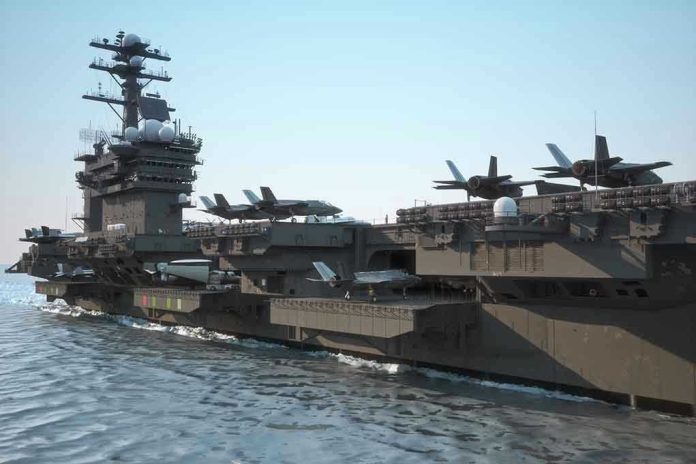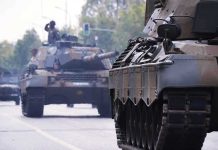
Two US Navy aircraft crashed 30 minutes apart from the same carrier in the South China Sea—yet not a single life was lost, and the real story is what these accidents reveal about the razor’s edge of American power projection in contested waters.
Story Snapshot
- Two major US Navy aircraft—an F/A-18F Super Hornet and MH-60R Sea Hawk—crashed within 30 minutes, both from USS Nimitz, in the South China Sea.
- All five crew members survived with no serious injuries, a rare outcome given the severity and timing of the incidents.
- The crashes occurred during routine operations amid US-China tensions, raising questions about operational risks and readiness.
- Investigations are underway, with no evidence yet of hostile action or linked mechanical failure.
Two Crashes, One Carrier, Thirty Minutes: Unpacking the Unthinkable
October 26, 2025, began as routine for the USS Nimitz, a floating fortress navigating the high-stakes South China Sea. At 2:45 p.m. local time, a MH-60R Sea Hawk helicopter from the “Battle Cats” squadron plunged into the water. Rescue teams scrambled, pulling all three crew members to safety. Thirty minutes later, the tension ratcheted higher as an F/A-18F Super Hornet from the “Fighting Redcocks” squadron crashed. Both pilots ejected and were swiftly recovered. Two aircraft, one ship, back-to-back emergencies—yet not a single fatality.
Surviving such a double blow is nearly unheard of in naval aviation. The South China Sea is not just any ocean—it’s a powder keg, its waters patrolled and surveilled by rival militaries. The Nimitz, on its final deployment, was transitioning from the Middle East, asserting US presence in an arena where Chinese and American interests collide daily. The twin crashes occurred while the crew operated under relentless scrutiny, their every move tracked by adversaries and allies alike.
The Strategic Chessboard Beneath the Waves
The South China Sea is an arena crowded with ambition and anxiety. China’s expansive territorial claims have prompted the US Navy to increase freedom of navigation operations, testing not just international law but the nerves and skills of every sailor aboard. The Nimitz, a symbol of American resolve, was tasked with reassuring regional allies and deterring Chinese assertiveness. In this setting, the margin for error shrinks. Routine operations carry extraordinary risks, and every incident reverberates far beyond the water’s edge.
No immediate evidence suggests hostile action or a mechanical link between the two crashes. Still, the coincidence is unsettling. Aviation and defense analysts point to the strain of high operational tempo, the unforgiving environment, and the possibility of systemic pressures unique to forward-deployed forces. Military scholars have long warned that the combination of strategic urgency and technical complexity can expose even the best-trained crews to cascading hazards.
Ripple Effects: Readiness, Reputation, and Regional Stakes
The immediate aftermath saw a flurry of rescue and recovery, a testament to the training and discipline instilled in Navy crews. Both aircraft were lost, but all personnel survived—an outcome that speaks volumes about safety protocols and quick decision-making. Still, the twin incidents bring short-term headaches: a temporary reduction in operational capability for the carrier group and intense scrutiny of maintenance, training, and leadership decisions.
Longer-term, the US Navy faces searching questions. Investigations will probe for any hint of mechanical commonality, lapses in protocol, or environmental triggers. The results may drive changes to maintenance regimens, training intensity, or even deployment patterns. At stake is more than just hardware—the credibility of American military reliability in a region where perception shapes policy. Regional allies, already watching US resolve with keen interest, will weigh these events alongside every diplomatic overture and military maneuver.
The Calculus of Risk in Modern Power Projection
The Nimitz incidents offer a rare window into the price of constant vigilance. Operating at the edge of contested waters, American forces balance deterrence and diplomacy while navigating hazards both natural and man-made. The fact that both crews survived reflects not just luck but the cumulative investment in training, technology, and a culture that refuses to accept unnecessary loss.
Defense experts caution against reading too much into coincidence, yet also warn against ignoring patterns. As the Navy combs over every data point, the world waits to see whether these crashes become footnotes or catalysts for change. In the South China Sea, the next chapter is always being written—sometimes in the churn of ocean spray, sometimes in the silence that follows averted tragedy.







